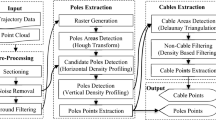Abstract
Vegetation interference with power lines is one of the most common causes of electrical outages of distribution systems and have a high potential of causing vast wildfires when combined with dry and hot weather under high wind conditions. The paper highlights the results of a case study of an approach using automated monitoring of vegetation and degree of its interference with power lines. It is based on the utilization of the so-called point clouds, which can be collected by terrestrial or airborne laser scanners or generated from stereoscopic images taken by drones. The approach allows the estimation of the location of the power lines in space and also allows the identification of the location of vegetation in the vicinity of the power lines. Sequential repetitive collections of the point cloud and its analysis allows us to automate the monitoring of vegetative growth and the quantification of the volume of vegetation to be removed to reduce or eliminate the hazard. In addition, the estimated shapes of the power lines are checked against the physically possible shapes to estimate their interference with large tree branches (for example, if a large branch with a lot of vegetation is resting on the power line). The advantages of the approach are presented in a case study of two typical power lines.









Similar content being viewed by others

References
Wikipedia (2019) Camp Fire (2018). https://en.wikipedia.org/wiki/Camp_Fire_(2018). Accessed 2 Jan 2020
KQED News (2019) PG&E Power Safety Shutoffs Could Continue for 10 Years, Says CEO. https://www.kqed.org/news/11781060/pge-power-safety-shutoffs-could-continue-for-10-years-says-ceo. Accessed 2 Jan 2020
Ahmad Junaid, Malik Aamir, Xia Likun, Ashikin Nadia (2013) Vegetation encroachment monitoring for transmission lines right-of-ways: a survey. Electr Power Syst Res. 95:339–352. https://doi.org/10.1016/j.epsr.2012.07.015
Li Z, Liu Y, Walker R et al (2010) Towards automatic power line detection for a UAV surveillance system using pulse coupled neural filter and an improved Hough transform. Mach Vis Appl 21:677–686. https://doi.org/10.1007/s00138-009-0206-y
Qayyum A, Malik AS, Saad MN, Iqbal M, Abdullah MF, Abdullah TA, Ramli AQ (2015) Power Lines Vegetation enchroachment monitoring based on satellite stereo images using stereo matching. In: 2014 IEEE international conference on smart instrumentation, measurement and applications, ICSIMA 2014. https://doi.org/10.1109/icsima.2014.7047425
Franken P (2003) Transmission line monitoring through airborne modelling. Management:1–9
McLaughlin R (2006) Extracting transmission lines from airborne LIDAR data. Geosci Remote Sens Lett 3:222–226. https://doi.org/10.1109/LGRS.2005.863390
Chaput LJ (2008) Understanding LiDAR data—how utilities can get maximum benefits from 3D modeling. International LiDAR Mapping Forum (ILMF) 2008, Denver, CO, USA, February 21–22, 2008
Jwa Y, Sohn G, Kim HB (2009) Automatic 3D power line reconstruction using airborne LIDAR data. IAPRS 38:8
Takhirov SM and Israilov MS (2019) Automated Monitoring of Vegetation Interference with Power Lines by Analysis of Point Clouds Combined with Cable Mechanics. In: Proceedings 9th international conference on structural health monitoring of intelligent infrastructure. August 4–7, 2019, St. Louis, Missouri, USA
Skaloud J, Lichti DD (2006) Rigorous approach to boresight self-calibration in airborne laser scanning. ISPRS J Photogramm Remote Sens 61(1):47–59
Jwa Y, Sohn G (2012) A piecewise catenary curve model growing for 3D power line reconstruction. Photogramm Eng Remote Sens 78(12):1227–1240
Trimble Inc (2016) The trimble TX6 laser scanner. http://trl.trimble.com/docushare/dsweb/Get/Document-824965/022516-282_TrimbleTX6_DS_US_1016_LR.pdf. Accessed 3 Jan 2020
Leica Geosystems AG (2015) Cyclone Version 9.1
Public Utilities Commission of the State of California (2015). GENERAL ORDER No. 95. Rules for Overhead Electric Line Construction. http://docs.cpuc.ca.gov/published/Graphics/13352.PDF. Accessed 10 Feb 2019
Lloyd SP (1982) Least squares quantization in PCM. IEEE Trans Inf Theory 28(1982):129–137
Arthur D and Vassilvitskii S (2007) K-means++: the advantages of careful seeding. In: SODA ‘07: Proceedings of the eighteenth annual ACM-SIAM symposium on discrete algorithms. pp 1027–1035
The MathWorks Inc (2019) Matlab Version R2019b
Todhunter I (1858) XI flexible strings. Inextensible; XII flexible strings. Extensible. In: a treatise on analytical statics. Macmillan
Meriam JL and Kraige LG (1997) Engineering mechanics. Statics. 4th ed. Vol 1. Willey, 524 pages
Pacific Gas and Electric Company (2020) Stay safe around power lines. https://www.pge.com/en_US/safety/electrical-safety/electrical-safety.page. Accessed 3 Jan 2020
California Energy Commission (2019) GIS Open Data. https://cecgis-caenergy.opendata.arcgis.com/. Accessed 10 Feb 2019
Leica Geosystems AG (2011) Leica ScanStation C10: Product Specifications. https://w3.leica-geosystems.com/downloads123/hds/hds/ScanStation%20C10/brochures-datasheet/Leica_ScanStation_C10_DS_en.pdf. Accessed 3 Jan 2020
Yashinsky M, Takhirov SM, Mosalam K, Hutchinson T and Kuester F (2014) From a distance: inspection of bridges in the aftermath of the South Napa Earthquake. Bridge Des Eng Mag 77:52–54
Acknowledgements
For the distribution power lines, Sensor Fusion and Monitoring Technologies, LLC provided a laser scanner, which is greatly appreciated. The point cloud of the 115-kV transmission line was collected during operations of the nees@berkeley laboratory, the University of California–Berkeley that was funded by the National Science Foundation.
Funding
The point cloud of the 115-kV transmission line was collected during operations of the nees@berkeley laboratory, the University of California–Berkeley in 2014 (Award No NEES-4101-31870), which was funded by the National Science Foundation.
Author information
Authors and Affiliations
Corresponding author
Ethics declarations
Conflict of Interest
The authors declare that they have no conflict of interest.
Additional information
Publisher's Note
Springer Nature remains neutral with regard to jurisdictional claims in published maps and institutional affiliations.
Rights and permissions
About this article
Cite this article
Takhirov, S.M., Israilov, M.S. Reduction of wildfire hazard by automated monitoring of vegetation interference with power lines: point cloud analysis combined with cable mechanics. J Civil Struct Health Monit 10, 947–956 (2020). https://doi.org/10.1007/s13349-020-00426-z
Received:
Revised:
Accepted:
Published:
Issue Date:
DOI: https://doi.org/10.1007/s13349-020-00426-z



